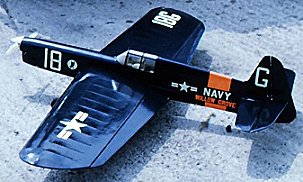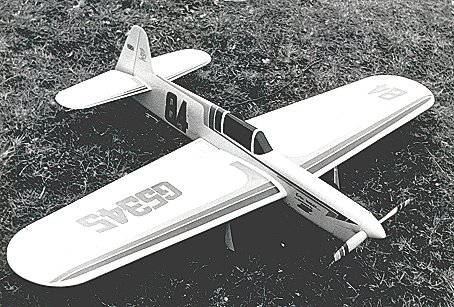


My method of filling a single vent tank required that I stand the model on its nose
At the time, I had serious doubts about the lifting fin that was a feature of the design. When the model was written off while flying in very strong winds, I felt that it was partly to blame. Most subsequent models had offset, or moving rudders, although I have recently returned to the fin as originally designed.
Number two was again built to the kit plan, but with a separate, offset, rudder. This one had the inevitable OS 35 and was finished in the later, dark blue, US Navy colours. While being flown at an SMAE Centralised meeting, the elevator pushrod detached itself from the horn at the bottom of a square loop. The result was an inverted landing with no more than a broken prop! Unbelievable though this may seem, I had an almost identical experience with a later model.
The luck didn't continue, however. At the 1963 Criterium of Aces, the motor stopped dead halfway up the first part of the reverse wingover and the model was totally destroyed. The American writers, Bill and Betty Bell, described this as 'instant garbage'.
Number three actually started life as the wing and tail of 'Iroquois IV'. This model had a wing-mounted undercarriage, which may have caused some aerodynamic problems. The result was a model which turned much tighter inside manoeuvres than outside. I thought that this might be related to the tubby fuselage, with radial cowl, so I rebuilt the model into a 'Nobler'. This did not solve the problem.
I then resorted to offsetting the flaps downwards in the hope of softening the inside turns (more flap) and tightening the outside turns (less flap). This was partially effective, but resulted in the model adopting a markedly nose up attitude when inverted. Despite this, it was a fairly successful model. While it never actually won anything, it had numerous seconds, including the 1964 Gold Trophy.
In the early 70's, I acquired a standard kit 'Nobler' which had been built by Mike Gagg. This had a tatty blue doped finish and I covered it with a coat of red polyeurethane to spruce it up a little. It kept my interest in C/L flying going while I was mainly concerned with R/C pylon racing. After suffering some minor damage, it was given away to a youngster in the Wolves club in 1974.
We now jump to 1978. After a long period of flying mostly R/C, apart from yearly appearances in the Gold Trophy flying my old 'Spacebird', I decided that I needed a new model. Lacking practice, I took Brian Horrocks advice and built 'Nobler' number five. Like the previous model, this had a wing-mounted undercarriage, but was otherwise standard, apart from a separate rudder. This was an Al Rabe style 'kicking rudder'. For recognition purposes, I always referred to this one as 'Nobler Still'.
One other innovation was that it was covered with 'Kwik-Kote' film. Having noted Mick Reeves use of film covering on his 'Dictator' design and having used film extensively for R/C models, I felt that this was acceptable. The whole model was covered with this material, including the fuselage, and it was entirely successful. This was mainly due to the superior nature of this particular film, which did not tend to become detached at the edges. The biggest gain was that the finished model weighed 38 ounces.
Once again, the old faithful OS 35 'Max 1' was used. This was the main problem, however, as it was well over the hill and refused to run consistently. This model also had an inclination to turn tighter insides than outsides.
For 1979, the motor was replaced by an ST 35, actually an R/C motor with the carburretor removed. This motor is still in use in various machines. This marked my return to serious stunt flying with 7 events entered during the year.
1980 got off to a good start and the model won the first SMAE Centralised meeting of the year. Flushed with this success, I decided to build yet another 'Nobler'. Some people never learn!
Number six had a number of changes from the standard kit. Apart from a wing-mounted undercarriage, the wing and tail were fully sheeted. Once again, I used an Al Rabe type rudder, but this was operated by a separate pushrod which went right back to the bellcrank, giving better control. Like both it's predecessors, it turned better on inside turns. This one became 'Even Nobler'.
At that time, the rules allowed various other control systems to be used provided they were done solely through the lines. Initially, I incorporated a system which would cut the motor after a predetermined number of control movements. This was never reliable and was replaced by a timer system which was initiated by the first up movement of the handle.
Finally, the model had an epoxy finish, This involved the use of a professional spray booth. While quite impressive, it was heavy! This was, by far, the heaviest 'Nobler' I built and weighed some 56 ounces. This was also a conspicuously unlucky model! It's contest history was marred by a succession of strange incidents. It also proved almost impossible to produce a good photo of it. When I gave it away to the previously mentioned Mike Gagg, the first thing he did was to break it. After repairs, it was stolen from his garage!
We now arrive at 1989 and the 'Nobler' contest held at the British Nationals and attended by George Aldrich himself. I needed a model, sans modifications, but didn't want to build yet another model from that old kit plan. The solution came in the form of the plan of George's original model which was being distributed by Ian Ward (since kitted by Brodak). This time I used the Merco 35 which had powered my 'Spacebird'.
Never one to follow the easy route, I started the model just 9 days before the contest. Having found a superb piece of wood from which to produce the tailplane and fin, I proceeded to carve a fin for clockwise flight! Serves me right for returning to that aerofoil rudder that I never liked.
Having flown number five in the Gold Trophy (a lowly 29th), I returned home on the Saturday night to finish and fuelproof the new model and returned to the Nats on Sunday morning. It's first flight was in the contest, in a thunderstorm, and it achieved first place. Good omen?
This model won the Nationals Classic event for the next five consecutive years (bringing the Merco's tally to 8 Nats wins). Henceforth, this was 'Noblest', short for 'the noblest Nobler of them all'. While it was certainly at it's best in very windy conditions, it was never a good-flying model. This was mainly due to the large difference (2.5 inches) in the length of the inner and outer wings. This caused the model to roll noticeably on square manoeuvres. I tried various ways of dealing with this, including a large tab on the outboard flap, but the difference was just too great.
Being built in a hurry meant that the model was never properly finished and it soon began to disintegrate. After nearly 200 flights it was scrapped.








